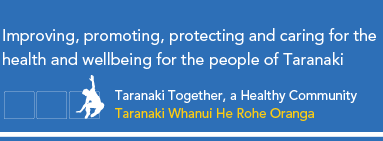Taranaki DHB prepared for Ebola
13 November 2014
The Ministry of Health’s assessment is that the risk to New Zealand from Ebola Virus Disease (EVD) remains low, and that health and border authorities are well prepared. It is very unlikely that anyone with EVD will arrive in New Zealand and extremely unlikely that EVD would spread within New Zealand.
The current EVD outbreak is mainly affecting three countries in West Africa (Sierra Leone, Guinea and Liberia), and even in these countries the disease is not common. There are very few people who travel from EVD -affected countries to New Zealand, and very few people who travel from New Zealand to those countries.
Taranaki DHB Chief Medical Advisor, Dr Greg Simmons said, “EVD is not easy to catch – it is not spread through the air and is not as infectious as the flu or measles. You can’t catch EVD just by sitting next to an infected person – it requires contact with infected body fluids (such as blood, saliva, urine or faeces) through broken skin or mucous membranes (such as the mouth or eyes). It is also important to note that people with EVD are not infectious before their symptoms appear.”
“People who have been in an EVD -affected country in the past 21 days, and develop fever or other symptoms of EVD , should phone their GP, nurse or Healthline on 0800 611 116 and say where they have been travelling,” said Dr Simmons. “If a person arrives at a health clinic (GP) or hospital, they will be assessed and asked about their recent overseas travel.”
“It is likely that at some stage a traveller will arrive in New Zealand who has a travel history and symptoms which mean they need to be tested for EVD – but it is much more likely that they will have another illness, such as malaria or some other disease which has symptoms similar to early EVD ” said Dr Simmons.
“If they fit the criteria for a suspected case of EVD , the health clinic or hospital will notify the local Medical Officer of Health and the Ministry of Health. Notification of a suspected case will trigger contact tracing and follow up by public health officers.”
“Testing for EVD will be carried out by a laboratory in Australia. It will take up to 72 hours for test results to be known,” added Dr Simmons.
Signs and symptoms of EVD appear between two and 21 days after infection (usually between eight and 10 days). Early signs and symptoms include sudden onset of fever , weakness, muscle and joint pains and headache. The initial symptoms are similar to other more common diseases such as the common cold, the flu or malaria.
As the disease progresses, symptoms can include bleeding from the nose, gums and bruising, diarrhoea (may be bloody), skin rash, sore throat and difficulty swallowing.
“New Zealand has routine border processes in place for managing ill travellers. Additional border screening was introduced on 10 August for individuals arriving from West African countries affected by the EVD outbreak,” said Dr Simmons.
“Existing isolation facilities and infection control protocols in New Zealand hospitals are suitable for treating a suspected or confirmed case of Ebola. Taranaki DHB has eight negative pressure rooms. These rooms incorporate a ventilation system which prevents contaminated air from being circulated from that room to other parts of the hospital.”
“All hospitals with negative pressure rooms would be capable of managing a suspected EVD patient. However, it is most likely that they would be treated at a tertiary level hospital – either Auckland, Middlemore, Wellington or Christchurch.”
“While the risk of a suspected EVD patient presenting in Taranaki is very low, the Taranaki DHB continues to work with the Ministry of Health, other District Health Boards and primary care to develop a comprehensive plan to respond to any suspected case of EVD in a traveller arriving from overseas, or family or friend who has had close contact with a traveller. Preparations include protection of other patients, staff and the community. We are also committed to maintaining patient confidentiality in line with our usual standards,” added Dr Simmons.
ENDS
For more information please call –
Cressida Gates, Media Advisor, Ph 027 703 6177
Last updated: Thursday, November 13, 2014


